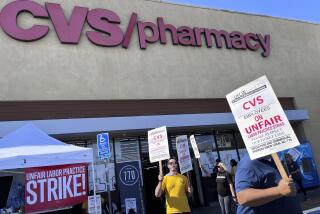Union blues
WITH Southern California’s supermarket chains and grocery union apparently making progress in their contract negotiations, the chances of a replay of the disastrous 141-day work stoppage in 2003-04 may be diminishing. After more than six months of negotiations between the United Food and Commercial Workers and Ralphs, Vons and Albertsons, differences on wages and pension issues reportedly have narrowed, though hurdles remain, especially on health insurance. For the workers, the risks of another walkout would be enormous. They lost big four years ago, and they have far fewer resources to draw on than the big chains. It’s a classic David-and-Goliath situation, and Goliath does not seem to be in a generous mood.
Labor strife is fairly new to the Southern California grocery industry. Before 2003, the region’s union contracts were among the best in the nation, providing pay and benefits that allowed non-college-educated workers to enjoy a decent standard of living, including excellent health insurance coverage. Today, however, the contracts in Southern California are among the worst in the country, with dramatically reduced health benefits and a two-tier wage and benefit structure that sharply divides longtime employees from newer ones.
This decline mirrors a broader power shift in labor/management relations, especially in the private sector. In 1973, about 24% of all U.S. workers in the private sector were union members. Today, the percentage is 7.4. The number is not much higher in Southern California -- 8.9% in the five-county region.
The supermarket industry, especially in Southern California, was a latecomer to union bashing. The region’s rapid population growth meant steadily expanding demand for groceries, and the big supermarket chains enjoyed a huge share of the market -- 57% as recently as 2002. Unionized for more than half a century, the industry had an unbroken record of labor peace going back 25 years. With all the major chains operating under a contract specifying uniform pay and benefits for workers, competition was based on service and quality, not on squeezing labor.
Then, four years ago, Vons, Ralphs and Albertsons did a 180-degree turn. For reasons that remain unknown, their leaders suddenly abandoned the high-road management approach and declared war on the labor-relations front.
To provoke a walkout, the chains presented the grocery workers union with a contract offer they knew would be rejected. When the union decided to strike Vons in response, Ralphs and Albertsons locked union workers out. All three firms meticulously prepared for the strike, as if it were a military operation. They hired thousands of replacement workers before the strike deadline, obtained commercial drivers’ licenses for managers and even recruited truck drivers to replace Teamsters who might walk out in sympathy. They also entered into a pact to share any profits for the duration of the strike, an arrangement later struck down in court.
The supermarket chains had won concessions from the union -- lower pay and fewer health benefits -- in parts of the Midwest and South, where Wal-Mart and other low-cost operators aggressively competed with them. Union jobs were on the line. But in the greater L.A. region, where Wal-Mart has yet to make any inroads in the grocery industry, there was no clear basis for similar concessions.
The Southern California union of 65,000 workers was caught off guard by the sudden and unprovoked attack on the living standards of its members. The decades of labor peace had left them unprepared for war. Fortunately for the grocery workers, the vast majority of shoppers honored the picket lines, in part because of strong personal ties between customers and checkers. Many shoppers began buying their food at other stores, such as Trader Joe’s and Whole Foods, which were among the few winners in the months-long conflict.
As a result, the supermarket chains lost billions in sales as well as a permanent share of the regional market. But it was the workers and their union that lost the most. Under the two-tier contract, new hires, who constitute half the workforce, can be paid as little as $7.55 an hour, only a nickel above California’s minimum wage. In addition, they must wait as long as 18 months before health benefits kick in, and even longer for family coverage.
For the union, the goal of the current negotiations is to retake some of the ground it lost in the last round and to avoid further concessions. The details of the negotiations are secret, but the supermarket chains reportedly have relaxed some of the time elements in the old two-tier contract so that employees would have to work fewer years to reach the top-pay scale.
Although it has not received much publicity, the fourth-largest unionized supermarket in Southern California, Stater Bros., signed a labor contract earlier this year that eliminates the two-tier wage system altogether and increases health and pension contributions for its 16,000 workers. Stater management took these steps because it was unhappy with the caliber of workers it was getting under the two-tier arrangement and with the high turnover rates that inevitably accompany low wages.
The Stater deal is a return to the high-road management approach that Vons, Ralphs and Albertsons abruptly abandoned four years ago. That Stater has gained market share in recent years suggests that profits and contracts favorable to workers are not mutually exclusive.
The two approaches to labor relations have vastly different implications for the larger community as well. Do we want to live in a world in which vast inequalities between rich and poor are the norm, or one in which a decent, middle-class standard of living is possible for those who do the unglamorous work of ringing up groceries and stocking store shelves? In the end, that’s precisely what is at stake in the impasse.
More to Read
Inside the business of entertainment
The Wide Shot brings you news, analysis and insights on everything from streaming wars to production — and what it all means for the future.
You may occasionally receive promotional content from the Los Angeles Times.










